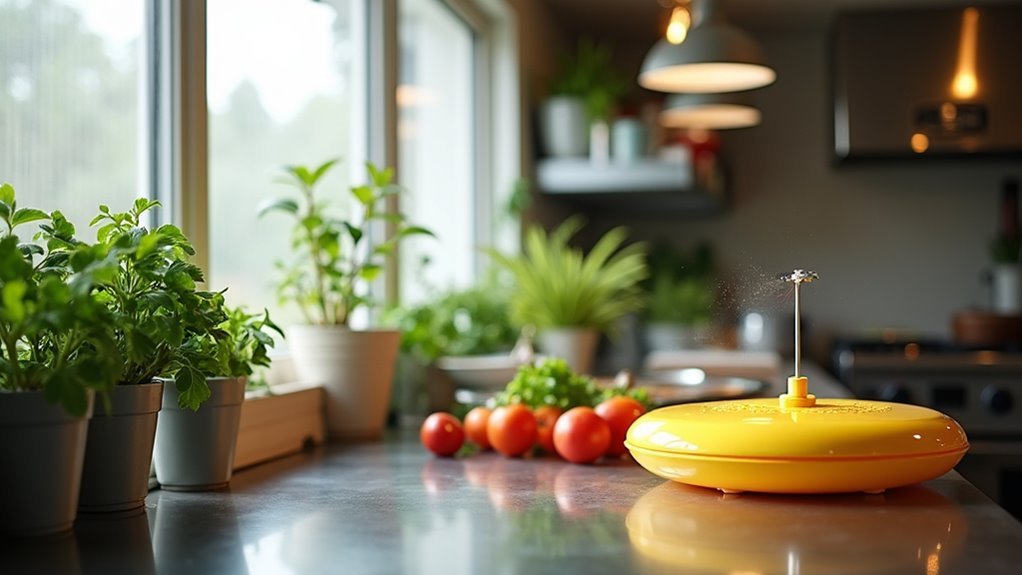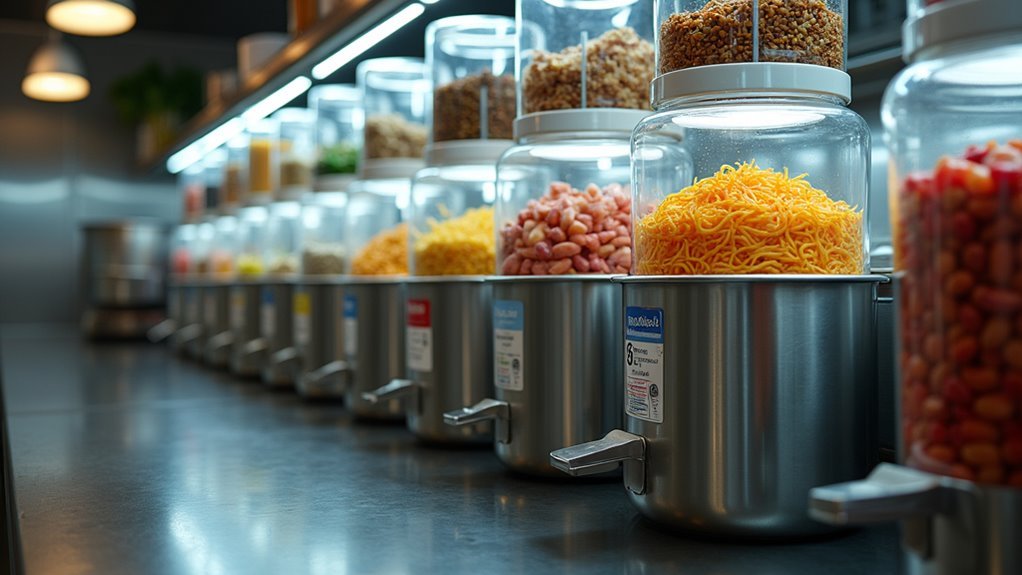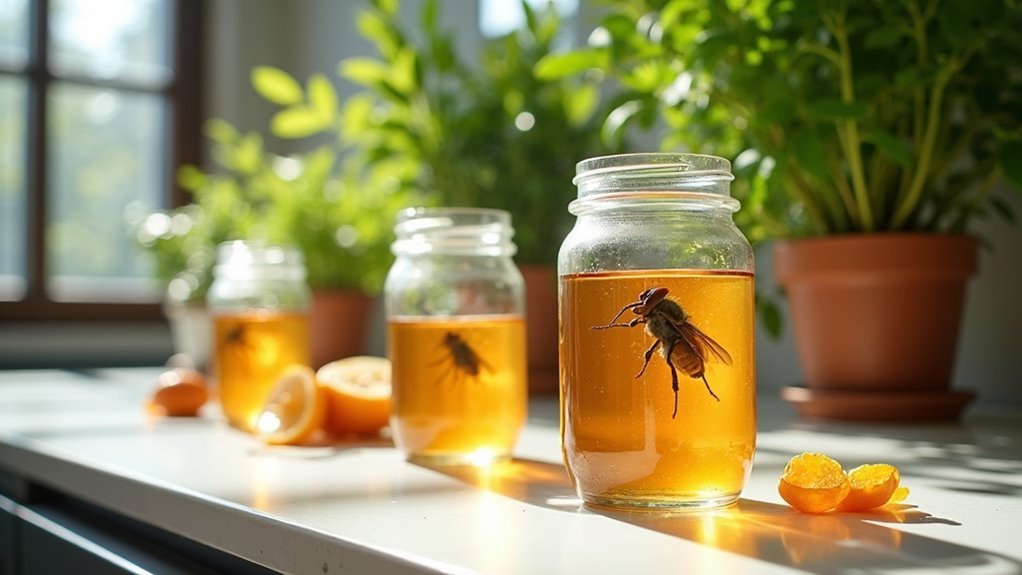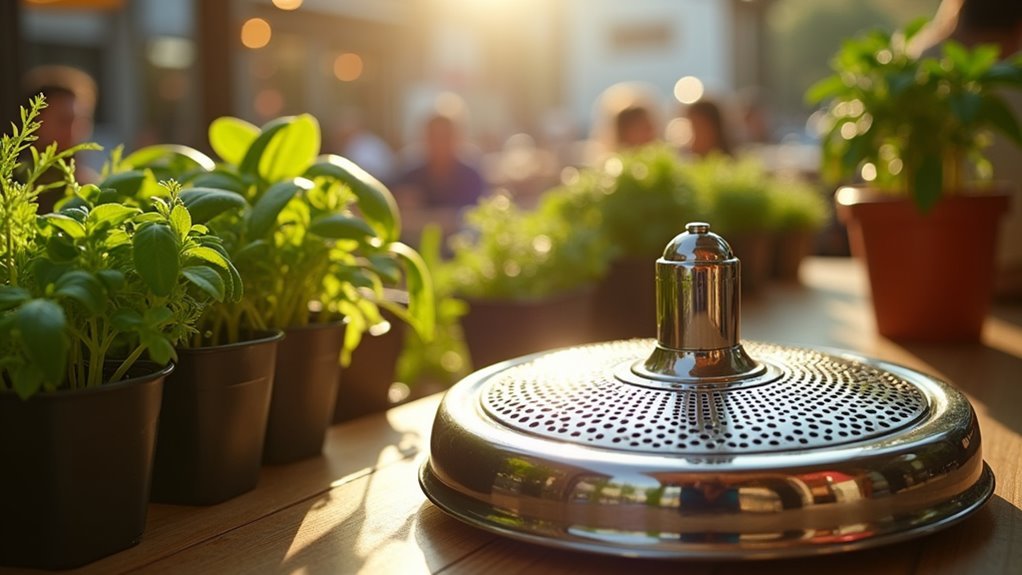Restaurants keep flies away easily because they’ve mastered entry prevention with air curtains that reduce fly entry by 90%, seal access points with door sweeps, and maintain rigorous sanitation protocols. You’ll see them targeting specific fly species like vinegar flies and drain flies with professional-grade equipment, implementing FIFO food storage methods, and training staff to address spills immediately. Their success comes from combining strategic prevention with targeted control systems that tackle root causes before infestations develop.
Understanding Common Restaurant Fly Species and Their Breeding Habits

Success in restaurant fly control begins with accurately identifying the specific species invading your establishment and understanding their unique breeding patterns.
You’ll commonly encounter four types: Vinegar Flies (3-4 mm) that thrive on yeasts from rotting fruit, Fruit Flies from the Tephritidae family that lay up to 500 eggs and mature within seven days around overripe fruit, Drain Flies (2-3 mm) that breed in organic material within drains, and Fungus Gnats (14 mm) attracted to overwatered plants.
Each species requires targeted pest control strategies. Fruit Flies gravitate toward overripe fruit in your restaurant kitchen, while Drain Flies establish colonies in drain buildup.
Understanding these breeding habits enables you to eliminate specific breeding sites rather than applying generic treatments that won’t address the root problem.
Essential Entry Prevention Methods for Commercial Kitchens
You need robust physical barriers to keep flies from entering your commercial kitchen in the first place.
Install air curtains at all exterior doors and drive-thru windows to create moving air barriers that deter fly entry.
Seal every gap with door sweeps and screen all vents opening to the outside to eliminate potential access points.
Install Air Curtains
While traditional door barriers can impede workflow in busy commercial kitchens, air curtains offer an invisible yet highly effective solution that blocks flies without disrupting staff movement.
These devices prevent flies from entering by creating a powerful air barrier at entry points, achieving up to 90% reduction in fly control when properly installed. Air curtains excel in maintaining a fly-free environment, especially in high-traffic areas like exterior doors and drive-thru windows.
Key benefits include:
- Enhance energy efficiency by maintaining temperature control and reducing heating/cooling costs
- Reduce fly entry without obstructing foot traffic or daily operations
- Provide cost-effective protection when combined with regular maintenance schedules
Seal Entry Points
Beyond installing air curtains, creating a thorough barrier against flies requires methodical attention to every potential entry point in your restaurant.
You’ll need to seal entry points systematically to keep flies away from your establishment. Install door sweeps on all exterior doors to eliminate gaps that typically allow pest access.
Add screens to vents and windows and doors that open outside, maintaining ventilation while blocking unwanted insects. Regular inspection and maintenance of window and door seals guarantees they close properly without tears or openings.
Keep all entry points closed during non-use periods, especially peak hours when food preparation attracts flies most.
This thorough approach will effectively prevent fly infestation in your commercial kitchen.
Screen All Openings
Installing screens on all windows, doors, and ventilation openings creates the most effective physical barrier against fly entry in commercial kitchens.
You’ll considerably reduce pest infiltration by implementing thorough screening throughout your facility.
Proper screen implementation requires three essential components:
- Fine mesh selection – Choose screens with tight weaves that block even the smallest flies while maintaining adequate airflow for your kitchen operations.
- Regular maintenance schedules – Inspect screens weekly for tears, holes, or damage that compromises their effectiveness as barriers against pest entry.
- Complete gap sealing – Eliminate spaces around screen frames and doors where flies might squeeze through, ensuring your protective barriers remain intact.
Air curtains complement your screening system by creating additional deterrent airstreams at high-traffic entrances, maintaining hygienic standards essential for regulatory compliance.
Identifying and Managing Critical Fly Hotspots in Food Service Areas
Since flies gravitate toward specific areas in restaurants where food particles, moisture, and organic waste accumulate, you’ll need to focus your prevention efforts on the most problematic zones.
Key fly hotspots include bar tops, dining tables, and garbage disposal areas that require immediate attention after use.
You must regularly clean and sanitize drains, sinks, and bar mats to eliminate organic material that creates breeding grounds.
Keep bus bins covered and clean them frequently to prevent odors from decaying matter.
Don’t neglect grease traps maintenance, as stagnant water and buildup attract drain flies.
Implement thorough staff training to guarantee spills and sticky residues get addressed promptly, protecting food safety and preventing fly infestations in high-traffic areas.
Proper Food Storage and Waste Management Techniques

While cleaning hotspots addresses immediate fly attractions, your storage and waste disposal practices form the foundation of long-term fly prevention.
Proper food storage begins with implementing FIFO methods to guarantee older items don’t spoil and attract flies. Store produce in sealed containers and inspect daily for over-ripe fruit that becomes a magnet for infestations.
Your waste management strategy should include:
- Regular cleaning and sanitizing of garbage containers and recycling bins to eliminate breeding grounds.
- Thawing meat in coolers overnight instead of at room temperature to minimize fly exposure.
- Properly maintaining grease traps to prevent organic matter accumulation in drains.
These practices eliminate the food sources and environments flies need to reproduce, creating an inhospitable environment that keeps your restaurant pest-free.
Professional-Grade Fly Control Equipment and Chemical Solutions
You’ll need professional-grade equipment when basic prevention methods aren’t enough to control persistent fly problems in your restaurant.
Commercial spray systems like automatic dispensers with natural pyrethrum formulations can effectively manage fly populations in your kitchen areas.
Industrial trapping devices, including electrocutors with ultraviolet light and strategically placed glue traps, provide extensive solutions that won’t disrupt your dining operations.
Commercial Spray Systems
When standard fly control methods aren’t cutting it, commercial spray systems deliver the professional-grade power your restaurant needs to eliminate persistent fly problems.
These systems target various fly species in restaurant environments using specialized insecticides designed for effective pest control.
You’ll benefit from three key advantages:
- Automatic or manual application guarantees consistent coverage in kitchens, dining areas, and waste zones.
- Eco-friendly formulations comply with food safety regulations while minimizing environmental impact.
- Strategic placement combined with other methods creates all-encompassing protection against fly infestations.
Regular maintenance and refilling maintain long-lasting barriers against flies.
When properly managed, these commercial spray systems provide robust protection that keeps your restaurant operations running smoothly without compromising customer experience or regulatory compliance.
Industrial Trapping Devices
Industrial trapping devices represent the heavy-duty solution for restaurants facing severe fly infestations that overwhelm basic control methods. You’ll find electrocutors particularly effective for thorough fly control, as they use UV light to attract flies before eliminating them. However, you must position these devices strategically away from food preparation areas to maintain proper hygiene standards.
| Device Type | Placement Strategy | Food Safety Benefit |
|---|---|---|
| Electrocutors | Away from kitchen | Maintains hygiene |
| Fly sticky paper | Hidden corners | Discreet capture |
| Residual sprays | Windowsills/tables | Long-term protection |
You can complement these industrial trapping devices with fly sticky paper in less visible areas and residual sprays on common resting spots like windowsills, creating a thorough defense system.
Creating Effective DIY Restaurant-Style Fly Traps

Several common household items can transform into powerful fly-catching tools that rival commercial traps in effectiveness.
You’ll find DIY fly traps particularly useful in high-traffic fly areas around food preparation zones where organic waste accumulates.
Here are three restaurant-style trap methods you can implement:
- Apple Cider Vinegar Solution – Mix vinegar with dish soap drops to attract fruit flies while trapping them effectively.
- Beer and Soap Combination – Create a shallow dish mixture targeting larger flies near organic waste areas.
- Overripe Fruit Traps – Place fermenting fruit in covered bowls with entry holes for an effective fruit fly trap.
Position these traps strategically around garbage bins and food prep stations.
Regular replacement guarantees peak performance in keeping flies away.
These preventative measures to keep your establishment fly-free cost considerably less than commercial alternatives.
Maintaining Long-Term Fly Prevention Through Staff Training and Protocols
While DIY traps provide immediate relief from fly problems, sustainable fly prevention requires thorough staff training and standardized protocols that address root causes.
You’ll need to train your team on cleanliness fundamentals, emphasizing immediate spill cleanup since flies are attracted to food residues and odors.
Implement strict food storage protocols like FIFO methods to prevent overripening that attracts fruit flies.
Create daily checklists for cleaning and inspecting fly hotspots including drains and garbage bins, fostering a proactive culture in pest management.
Train staff to recognize early fly activity signs such as buzzing or larvae presence.
Regular refresher sessions on pest control measures reinforce proper protocols, ensuring your team maintains long-term fly prevention standards effectively.
Frequently Asked Questions
How Do Restaurants Keep Flies Away?
You’ll find restaurants use air curtains at doors, clean spills immediately, store food properly in sealed containers, install fly fans, and regularly inspect drains to eliminate breeding sites and food sources.
Why Are There so Many Flies in My Restaurant?
You’ve likely got food spills, dirty drains, or improper waste storage creating breeding grounds. Flies reproduce rapidly in restaurants due to cooking odors, organic waste, and accessible food sources attracting them constantly.
Why Do Pennies in Water Keep Flies Away?
Pennies in water create reflective surfaces that confuse flies’ compound eyes, making navigation difficult. The copper may also emit scents that repel insects, though you’ll need more thorough methods for effective restaurant fly control.
What Smell Do Flies Hate the Most?
You’ll find flies hate peppermint, eucalyptus, and citrus scents the most. Essential oils from these sources create strong aromas that effectively repel flies, making them excellent choices for natural pest control in any space.
In Summary
You’ll succeed in keeping flies away by combining multiple strategies consistently. Don’t rely on just one method—use proper sanitation, seal entry points, manage waste effectively, and deploy professional-grade equipment together. Train your staff to maintain these protocols daily, and you’ll create an environment that’s naturally inhospitable to flies. Remember, prevention’s always easier than elimination, so stay proactive with your fly control measures for lasting results.





Leave a Reply